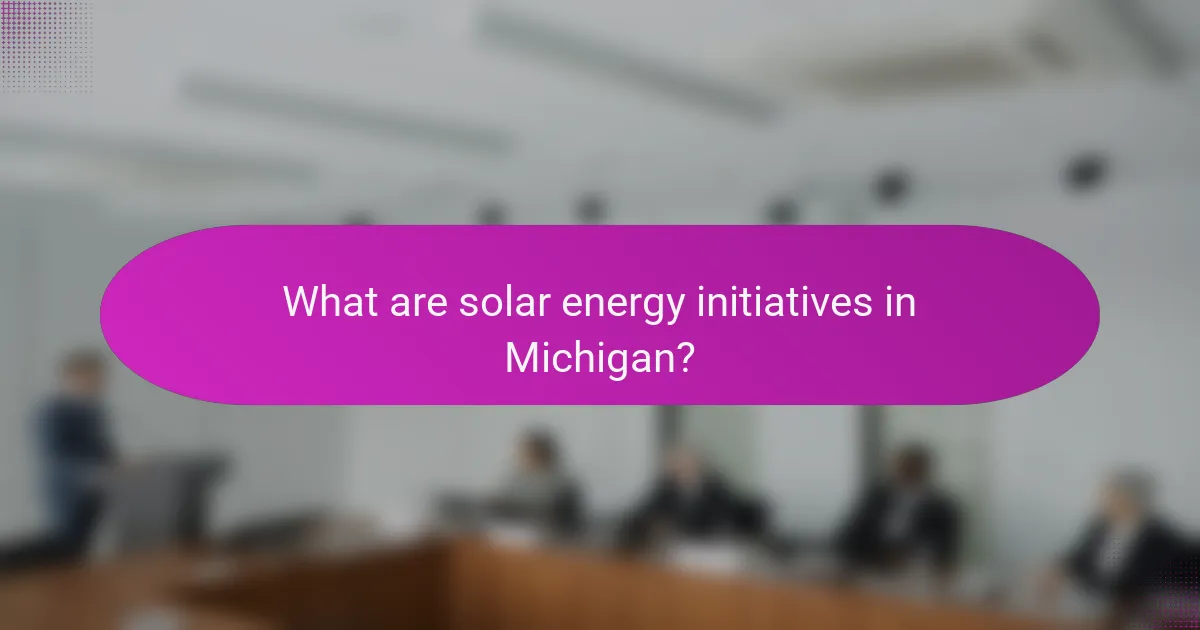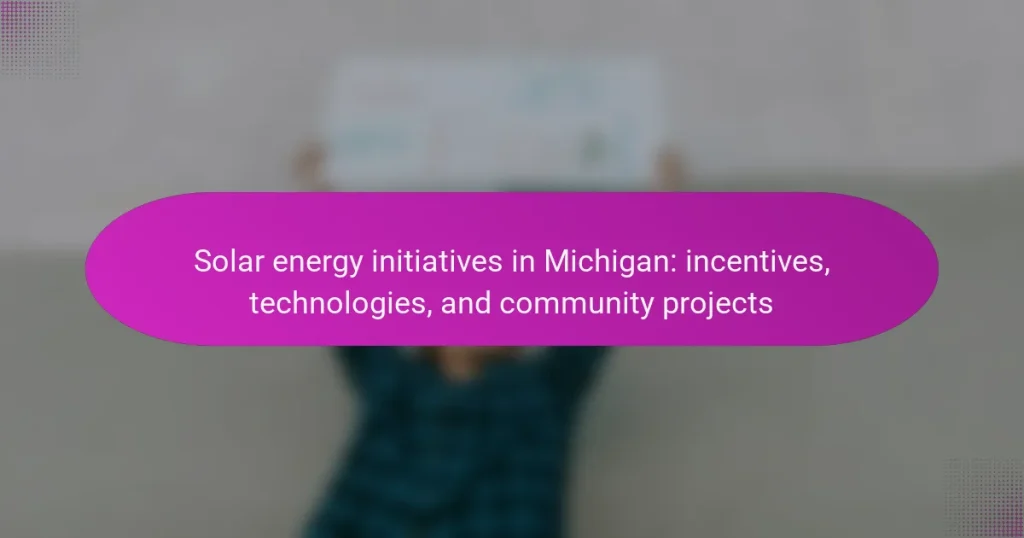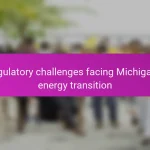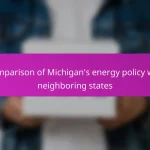
What are solar energy initiatives in Michigan?
Solar energy initiatives in Michigan include a range of programs aimed at increasing solar energy adoption. The Michigan Energy Innovation Business Council promotes policies for solar energy growth. The state offers incentives like the Solar Renewable Energy Credit program. This program allows solar energy producers to earn credits for the energy they generate. Additionally, local governments often provide property tax exemptions for solar installations. Community solar projects are also emerging, allowing residents to invest in shared solar arrays. Michigan’s renewable portfolio standard mandates utilities to source a percentage of their energy from renewable sources, including solar. According to the Michigan Public Service Commission, solar capacity in the state has significantly increased in recent years, reflecting growing interest and investment in solar technologies.
How do solar energy initiatives impact the state’s energy landscape?
Solar energy initiatives significantly transform the state’s energy landscape. They increase renewable energy production, reducing reliance on fossil fuels. In Michigan, solar capacity has grown by over 300% since 2015. This growth contributes to energy diversification and grid stability. Solar initiatives also create jobs in installation and maintenance sectors. According to the Solar Foundation’s National Solar Jobs Census, Michigan added nearly 5,000 solar jobs in recent years. Furthermore, these initiatives promote energy independence and local energy solutions. They empower communities to generate their own electricity, enhancing sustainability efforts. Overall, solar energy initiatives are reshaping Michigan’s energy future.
What are the goals of these initiatives?
The goals of solar energy initiatives in Michigan include increasing renewable energy adoption and reducing greenhouse gas emissions. These initiatives aim to promote energy independence and sustainability. They seek to provide financial incentives for homeowners and businesses to install solar technology. Additionally, the initiatives focus on developing community solar projects to expand access to solar energy. By enhancing job creation in the renewable sector, these initiatives contribute to economic growth. They also aim to educate the public about the benefits of solar energy. Overall, these goals align with Michigan’s commitment to a cleaner energy future.
How do these initiatives align with Michigan’s environmental policies?
Solar energy initiatives in Michigan align with the state’s environmental policies by promoting renewable energy use. These initiatives support Michigan’s goal to reduce greenhouse gas emissions by 28% by 2025. They also enhance energy efficiency, which is a key component of the state’s environmental strategy. Furthermore, the initiatives contribute to the Clean Energy Act’s objectives of increasing renewable energy production to 50% by 2030. By providing incentives for solar installations, Michigan encourages sustainable practices. This alignment demonstrates a commitment to combating climate change and fostering a healthier environment for residents.
What types of incentives are available for solar energy in Michigan?
In Michigan, several incentives are available for solar energy. These include a state tax credit, net metering, and property tax exemptions. The Michigan state tax credit allows homeowners to receive a credit of 26% of their solar system costs. Net metering enables solar energy users to receive credits for excess electricity they generate. Additionally, property tax exemptions prevent increases in property taxes due to solar installations. These incentives aim to promote solar energy adoption and reduce overall costs for consumers.
Which financial incentives can residents and businesses access?
Residents and businesses in Michigan can access various financial incentives for solar energy. These include the federal Investment Tax Credit (ITC), which allows a 26% tax credit on solar system costs. Additionally, Michigan offers a Property Tax Exemption for solar energy systems, meaning increased property value from solar installations is not taxed. There are also rebates available through local utility companies. These rebates can significantly reduce the upfront costs of solar installations. Furthermore, the Michigan Saves program provides low-interest loans for energy efficiency upgrades, including solar projects. These financial incentives promote the adoption of solar energy in the state.
How do tax credits and rebates work for solar energy projects?
Tax credits and rebates for solar energy projects reduce the overall cost of installation. Tax credits allow homeowners and businesses to deduct a percentage of the installation cost from their federal or state taxes. For example, the federal solar tax credit offers a 26% deduction on qualified expenses for systems installed by the end of 2022. Rebates provide direct cash payments or discounts from local or state programs based on the system’s capacity or performance. In Michigan, utility companies may offer additional rebates to encourage solar adoption. These financial incentives significantly lower the upfront investment required for solar energy systems, making them more accessible to consumers.
What technologies are utilized in Michigan’s solar energy initiatives?
Michigan’s solar energy initiatives utilize photovoltaic (PV) systems and solar thermal technologies. PV systems convert sunlight directly into electricity using solar panels. These panels are commonly made from silicon-based materials. Solar thermal technologies capture sunlight to heat water or air for residential and commercial use. Michigan has also implemented energy storage systems to enhance the reliability of solar power. These systems store excess energy generated during sunny periods for use during cloudy days or at night. Additionally, tracking systems are employed to optimize solar panel orientation. These technologies collectively support Michigan’s goal of increasing renewable energy use and reducing greenhouse gas emissions.
What are the most common solar technologies implemented?
The most common solar technologies implemented are photovoltaic (PV) systems and solar thermal systems. PV systems convert sunlight directly into electricity using solar panels. These systems are widely used for residential and commercial energy needs. Solar thermal systems capture sunlight to generate heat for water or space heating. These systems are often used in residential applications for hot water production. According to the Solar Energy Industries Association, PV systems accounted for over 90% of solar capacity installed in the U.S. in 2022. This highlights the dominance of PV technology in the solar market. Solar thermal systems, while less common, still play a significant role, particularly in areas with high hot water demand.
How do these technologies contribute to energy efficiency?
Solar energy technologies enhance energy efficiency by converting sunlight into usable electricity. These technologies, such as photovoltaic panels and solar thermal systems, reduce reliance on fossil fuels. By harnessing renewable energy, they lower greenhouse gas emissions. Solar installations can significantly decrease utility bills for homeowners and businesses. In Michigan, various incentives encourage adoption, further promoting energy efficiency. According to the U.S. Department of Energy, solar energy can reduce energy consumption by up to 50% in some applications. Overall, these technologies play a crucial role in creating a sustainable energy future.
What community projects are associated with solar energy in Michigan?
Several community projects associated with solar energy exist in Michigan. Notable initiatives include the Solarize Michigan program, which helps communities install solar panels through group purchasing. The City of Ann Arbor has implemented the Solar Ann Arbor project, promoting residential solar installations. Additionally, the Michigan Energy Options organization runs community solar programs, allowing residents to invest in solar energy without installing panels on their property. The Michigan Department of Environment, Great Lakes, and Energy supports various local solar projects through funding and resources. These projects collectively aim to increase solar adoption and promote renewable energy in the state.
Which organizations are leading solar community initiatives?
The leading organizations in solar community initiatives include the Michigan Energy Office, the Midwest Renewable Energy Association, and the Solar Energy Industries Association. The Michigan Energy Office promotes solar energy through various programs and incentives. The Midwest Renewable Energy Association focuses on education and advocacy for renewable energy. The Solar Energy Industries Association represents the solar industry and works to advance solar energy initiatives. These organizations collaborate to enhance solar adoption and support community projects across Michigan.
How do community solar projects benefit local residents?
Community solar projects benefit local residents by providing access to renewable energy. These projects enable individuals to participate in solar energy generation without needing to install panels on their properties. Residents can save on energy costs through shared savings from the community solar program.
Additionally, community solar projects can enhance local economies by creating jobs in installation and maintenance. According to the Solar Energy Industries Association, solar jobs have increased significantly, contributing to local employment rates. Furthermore, these projects promote energy independence and resilience in local communities.
They also help reduce greenhouse gas emissions, supporting environmental sustainability efforts. In Michigan, community solar initiatives have been developed to ensure more equitable access to solar energy. This inclusivity allows low-income households to benefit from renewable energy, previously limited to property owners. Overall, community solar projects foster a sense of community while promoting economic and environmental benefits.
How can individuals get involved in solar energy initiatives in Michigan?
Individuals can get involved in solar energy initiatives in Michigan by participating in community solar programs. These programs allow residents to invest in solar energy without needing to install panels on their homes. Many local utilities offer community solar projects that provide shared solar power.
Additionally, individuals can join local advocacy groups focused on renewable energy. Organizations such as the Michigan Energy Options and the Michigan Solar Association promote solar energy awareness and policy changes.
Volunteering for educational workshops and events also helps raise awareness about solar initiatives. Many communities host events to inform residents about solar benefits and installation processes.
Finally, individuals can consider installing solar panels on their properties. The state offers various incentives, such as tax credits and rebates, to encourage solar adoption. According to the Michigan Agency for Energy, these incentives can significantly reduce installation costs.
What steps can residents take to participate in local solar programs?
Residents can participate in local solar programs by following several steps. First, they should research available solar programs in their area. This includes checking local government websites and community solar initiatives. Next, residents can evaluate their energy needs and assess the suitability of their property for solar installation. They should consider factors like roof orientation and shading. Afterward, residents can reach out to local solar providers for consultations and quotes. This will help them understand installation costs and potential savings. Additionally, they should explore financing options such as solar loans or leasing. Finally, residents can apply for any available incentives or rebates to reduce costs. Engaging with local community groups focused on solar energy can also provide valuable information and support.
How can communities advocate for more solar energy projects?
Communities can advocate for more solar energy projects by organizing awareness campaigns. These campaigns educate residents about the benefits of solar energy. They can also host community meetings to discuss solar initiatives. Collaborating with local governments helps in gaining support for policy changes. Communities can form partnerships with solar companies to explore project opportunities. Engaging in public comment periods for energy plans allows residents to voice their support. Additionally, communities can apply for grants that fund solar projects. In Michigan, the Solar Energy Association provides resources for advocacy efforts.
What are the challenges facing solar energy initiatives in Michigan?
The challenges facing solar energy initiatives in Michigan include regulatory hurdles, high installation costs, and limited grid infrastructure. Michigan’s regulations can create barriers for new solar projects. The upfront cost of solar systems remains a significant obstacle for many residents and businesses. Additionally, the state’s grid infrastructure may not fully support the integration of renewable energy sources. According to the Michigan Public Service Commission, these factors can slow the growth of solar energy in the region.
What barriers do residents encounter when adopting solar energy?
Residents encounter several barriers when adopting solar energy. High initial costs are a significant hurdle. The average installation cost for solar panels can exceed $20,000 before incentives. Limited access to financing options also poses challenges. Many residents lack knowledge about available loans or leasing options. Additionally, homeowners may face regulatory hurdles. Local zoning laws and building codes can complicate installation processes. The lack of adequate sunlight in some areas further limits solar energy potential. Moreover, misinformation about solar technology can lead to skepticism among residents. These factors collectively hinder the widespread adoption of solar energy in communities.
How can these challenges be addressed moving forward?
Challenges in solar energy initiatives in Michigan can be addressed through policy reforms, increased funding, and community engagement. Implementing supportive legislation can enhance incentives for solar adoption. Expanding financial resources for solar projects will lower costs for residents and businesses. Promoting educational programs will raise awareness about the benefits of solar energy. Collaborating with local organizations can strengthen community support for solar initiatives. Utilizing advanced technologies can improve efficiency and energy storage. The Michigan Public Service Commission reported that streamlined permitting processes can accelerate project deployment. Overall, these strategies can create a more favorable environment for solar energy growth in Michigan.
What best practices should be followed when considering solar energy in Michigan?
When considering solar energy in Michigan, homeowners should assess their energy needs first. Evaluating the size and orientation of the roof is crucial for optimal solar panel placement. Researching local solar incentives and rebates can significantly reduce installation costs. Consulting with certified solar installers ensures compliance with state regulations and quality installation. Understanding net metering policies helps maximize energy savings. Regular maintenance of solar panels is necessary for long-term efficiency. Engaging with local solar energy communities can provide valuable insights and support. Finally, monitoring energy production and consumption aids in optimizing solar energy use.
Solar energy initiatives in Michigan encompass various programs designed to enhance solar energy adoption through incentives, technologies, and community projects. Key incentives include state tax credits, net metering, and property tax exemptions aimed at reducing installation costs for residents and businesses. The article explores the impact of these initiatives on Michigan’s energy landscape, highlighting significant growth in solar capacity and job creation. It also details the technologies employed, such as photovoltaic systems and solar thermal solutions, and discusses community solar projects that promote equitable access to renewable energy. Lastly, the article addresses the challenges faced by these initiatives and best practices for residents considering solar energy.


